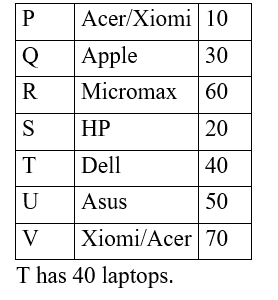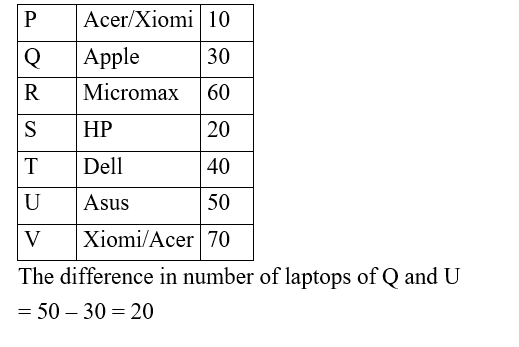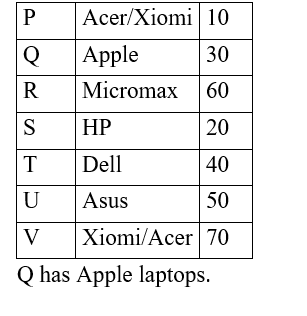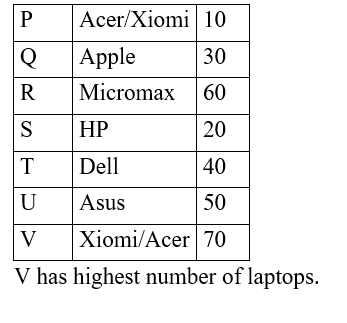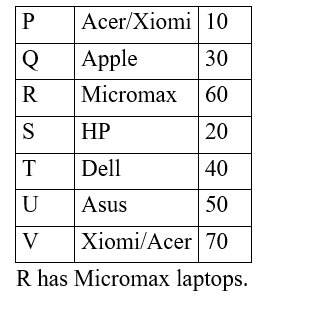Question 1:
निर्देश : दिए गए जानकारी के आधार पर सवालों के उत्तर दें।
Directions : Answer the questions based on the information given below.
सात व्यक्ति P, Q, R, S, T, U और V के पास भिन्न-भिन्न संख्या में लैपटॉप हैं - 10, 20, 30, 40, 50, 60 और 70।
Seven persons P, Q, R, S, T, U and V have different number of laptops among 10, 20, 30, 40, 50, 60 and 70.
इनमे से प्रत्येक के पास भिन्न भिन्न ब्रांडों के लैपटॉप हैं - एसर, एप्पल, आसुस, डेल, एचपी, माइक्रोमैक्स और श्याओमी।
Each of them has laptops of different brands among Acer, Apple, Asus, Dell, HP, Micromax and Xiomi.
S के पास एचपी ब्रांड का लैपटॉप है। Q के पास 30 लैपटॉप है। P और T (जिसके पास डेल लैपटॉप है) के लैपटॉप की संख्या के बीच का अंतर 30 है पर इनमे से किसी भी व्यक्ति के पास 70 लैपटॉप नहीं है। एक व्यक्ति के पास 60 माइक्रोमैक्स लैपटॉप है। ना ही U ना ही V के पास माइक्रोमैक्स या एप्पल लैपटॉप है। P के पास उस व्यक्ति से कम लैपटॉप है, जिसके पास एप्पल लैपटॉप है। U के पास T से अधिक लैपटॉप है पर सबसे अधिक नहीं। V के पास उस व्यक्ति से अधिक लैपटॉप है, जिसके पास आसुस लैपटॉप है। P के पास उस व्यक्ति से कम लैपटॉप है, जिसके पास आसुस लैपटॉप है।
S has laptops of HP brand. Q has 30 laptops. The difference in number of laptops of P and T, who has Dell laptops, is 30 but none of them has 70 laptops. One person has 60 Micromax laptops. Neither U nor V has Micromax or Apple laptop. P has lesser laptops than the one, who has Apple laptops. U has more laptops than T but not the highest. V has more laptops than the one, who has Asus laptops. P has lesser laptops than the one, who has Asus laptops.
निम्नलिखित में से किस व्यक्ति के पास 40 लैपटॉप है?
Who among the following has 40 laptops?
Question 2:
निर्देश : दिए गए जानकारी के आधार पर सवालों के उत्तर दें।
Directions : Answer the questions based on the information given below.
सात व्यक्ति P, Q, R, S, T, U और V के पास भिन्न-भिन्न संख्या में लैपटॉप हैं - 10, 20, 30, 40, 50, 60 और 70।
Seven persons P, Q, R, S, T, U and V have different number of laptops among 10, 20, 30, 40, 50, 60 and 70.
इनमे से प्रत्येक के पास भिन्न भिन्न ब्रांडों के लैपटॉप हैं - एसर, एप्पल, आसुस, डेल, एचपी, माइक्रोमैक्स और श्याओमी।
Each of them has laptops of different brands among Acer, Apple, Asus, Dell, HP, Micromax and Xiomi.
S के पास एचपी ब्रांड का लैपटॉप है। Q के पास 30 लैपटॉप है। P और T (जिसके पास डेल लैपटॉप है) के लैपटॉप की संख्या के बीच का अंतर 30 है पर इनमे से किसी भी व्यक्ति के पास 70 लैपटॉप नहीं है। एक व्यक्ति के पास 60 माइक्रोमैक्स लैपटॉप है। ना ही U ना ही V के पास माइक्रोमैक्स या एप्पल लैपटॉप है। P के पास उस व्यक्ति से कम लैपटॉप है, जिसके पास एप्पल लैपटॉप है। U के पास T से अधिक लैपटॉप है पर सबसे अधिक नहीं। V के पास उस व्यक्ति से अधिक लैपटॉप है, जिसके पास आसुस लैपटॉप है। P के पास उस व्यक्ति से कम लैपटॉप है, जिसके पास आसुस लैपटॉप है।
S has laptops of HP brand. Q has 30 laptops. The difference in number of laptops of P and T, who has Dell laptops, is 30 but none of them has 70 laptops. One person has 60 Micromax laptops. Neither U nor V has Micromax or Apple laptop. P has lesser laptops than the one, who has Apple laptops. U has more laptops than T but not the highest. V has more laptops than the one, who has Asus laptops. P has lesser laptops than the one, who has Asus laptops.
Q और U के लैपटॉप की संख्या के बीच का अंतर कितना है?
What is the difference in number of laptops of Q and U?
Question 3:
निर्देश : दिए गए जानकारी के आधार पर सवालों के उत्तर दें।
Directions : Answer the questions based on the information given below.
सात व्यक्ति P, Q, R, S, T, U और V के पास भिन्न-भिन्न संख्या में लैपटॉप हैं - 10, 20, 30, 40, 50, 60 और 70।
Seven persons P, Q, R, S, T, U and V have different number of laptops among 10, 20, 30, 40, 50, 60 and 70.
इनमे से प्रत्येक के पास भिन्न भिन्न ब्रांडों के लैपटॉप हैं - एसर, एप्पल, आसुस, डेल, एचपी, माइक्रोमैक्स और श्याओमी।
Each of them has laptops of different brands among Acer, Apple, Asus, Dell, HP, Micromax and Xiomi.
S के पास एचपी ब्रांड का लैपटॉप है। Q के पास 30 लैपटॉप है। P और T (जिसके पास डेल लैपटॉप है) के लैपटॉप की संख्या के बीच का अंतर 30 है पर इनमे से किसी भी व्यक्ति के पास 70 लैपटॉप नहीं है। एक व्यक्ति के पास 60 माइक्रोमैक्स लैपटॉप है। ना ही U ना ही V के पास माइक्रोमैक्स या एप्पल लैपटॉप है। P के पास उस व्यक्ति से कम लैपटॉप है, जिसके पास एप्पल लैपटॉप है। U के पास T से अधिक लैपटॉप है पर सबसे अधिक नहीं। V के पास उस व्यक्ति से अधिक लैपटॉप है, जिसके पास आसुस लैपटॉप है। P के पास उस व्यक्ति से कम लैपटॉप है, जिसके पास आसुस लैपटॉप है।
S has laptops of HP brand. Q has 30 laptops. The difference in number of laptops of P and T, who has Dell laptops, is 30 but none of them has 70 laptops. One person has 60 Micromax laptops. Neither U nor V has Micromax or Apple laptop. P has lesser laptops than the one, who has Apple laptops. U has more laptops than T but not the highest. V has more laptops than the one, who has Asus laptops. P has lesser laptops than the one, who has Asus laptops.
Q के पास ____ लैपटॉप है।
Q has ______ laptops.
Question 4:
निर्देश : दिए गए जानकारी के आधार पर सवालों के उत्तर दें।
Directions : Answer the questions based on the information given below.
सात व्यक्ति P, Q, R, S, T, U और V के पास भिन्न-भिन्न संख्या में लैपटॉप हैं - 10, 20, 30, 40, 50, 60 और 70।
Seven persons P, Q, R, S, T, U and V have different number of laptops among 10, 20, 30, 40, 50, 60 and 70.
इनमे से प्रत्येक के पास भिन्न भिन्न ब्रांडों के लैपटॉप हैं - एसर, एप्पल, आसुस, डेल, एचपी, माइक्रोमैक्स और श्याओमी।
Each of them has laptops of different brands among Acer, Apple, Asus, Dell, HP, Micromax and Xiomi.
S के पास एचपी ब्रांड का लैपटॉप है। Q के पास 30 लैपटॉप है। P और T (जिसके पास डेल लैपटॉप है) के लैपटॉप की संख्या के बीच का अंतर 30 है पर इनमे से किसी भी व्यक्ति के पास 70 लैपटॉप नहीं है। एक व्यक्ति के पास 60 माइक्रोमैक्स लैपटॉप है। ना ही U ना ही V के पास माइक्रोमैक्स या एप्पल लैपटॉप है। P के पास उस व्यक्ति से कम लैपटॉप है, जिसके पास एप्पल लैपटॉप है। U के पास T से अधिक लैपटॉप है पर सबसे अधिक नहीं। V के पास उस व्यक्ति से अधिक लैपटॉप है, जिसके पास आसुस लैपटॉप है। P के पास उस व्यक्ति से कम लैपटॉप है, जिसके पास आसुस लैपटॉप है।
S has laptops of HP brand. Q has 30 laptops. The difference in number of laptops of P and T, who has Dell laptops, is 30 but none of them has 70 laptops. One person has 60 Micromax laptops. Neither U nor V has Micromax or Apple laptop. P has lesser laptops than the one, who has Apple laptops. U has more laptops than T but not the highest. V has more laptops than the one, who has Asus laptops. P has lesser laptops than the one, who has Asus laptops.
निम्नलिखित में से किस व्यक्ति के पास लैपटॉप की सबसे अधिक संख्या है?
Who among the following has highest number of laptops?
Question 5:
निर्देश : दिए गए जानकारी के आधार पर सवालों के उत्तर दें।
Directions : Answer the questions based on the information given below.
सात व्यक्ति P, Q, R, S, T, U और V के पास भिन्न-भिन्न संख्या में लैपटॉप हैं - 10, 20, 30, 40, 50, 60 और 70।
Seven persons P, Q, R, S, T, U and V have different number of laptops among 10, 20, 30, 40, 50, 60 and 70.
इनमे से प्रत्येक के पास भिन्न भिन्न ब्रांडों के लैपटॉप हैं - एसर, एप्पल, आसुस, डेल, एचपी, माइक्रोमैक्स और श्याओमी।
Each of them has laptops of different brands among Acer, Apple, Asus, Dell, HP, Micromax and Xiomi.
S के पास एचपी ब्रांड का लैपटॉप है। Q के पास 30 लैपटॉप है। P और T (जिसके पास डेल लैपटॉप है) के लैपटॉप की संख्या के बीच का अंतर 30 है पर इनमे से किसी भी व्यक्ति के पास 70 लैपटॉप नहीं है। एक व्यक्ति के पास 60 माइक्रोमैक्स लैपटॉप है। ना ही U ना ही V के पास माइक्रोमैक्स या एप्पल लैपटॉप है। P के पास उस व्यक्ति से कम लैपटॉप है, जिसके पास एप्पल लैपटॉप है। U के पास T से अधिक लैपटॉप है पर सबसे अधिक नहीं। V के पास उस व्यक्ति से अधिक लैपटॉप है, जिसके पास आसुस लैपटॉप है। P के पास उस व्यक्ति से कम लैपटॉप है, जिसके पास आसुस लैपटॉप है।
S has laptops of HP brand. Q has 30 laptops. The difference in number of laptops of P and T, who has Dell laptops, is 30 but none of them has 70 laptops. One person has 60 Micromax laptops. Neither U nor V has Micromax or Apple laptop. P has lesser laptops than the one, who has Apple laptops. U has more laptops than T but not the highest. V has more laptops than the one, who has Asus laptops. P has lesser laptops than the one, who has Asus laptops.
______ के पास माइक्रोमैक्स लैपटॉप है।
_____ has Micromax laptops.
Question 6:
निर्देश : नीचे दी गई जानकारी के आधार पर प्रश्नों के उत्तर दें।
Directions : Answer the questions based on the information given below.
12 व्यक्ति दो समानांतर पंक्तियों में इस प्रकार बैठे हैं कि प्रत्येक पंक्ति में छह व्यक्ति बैठे हैं। P, Q, R, S, T और U पंक्ति 1 में बैठे हैं जबकि A, B, C, D, E और F पंक्ति 2 में बैठे हैं। पंक्ति 1 में बैठे व्यक्तियों का मुख दक्षिण की तरफ और पंक्ति 2 में बैठे व्यक्तियों का मुख उत्तर की ओर हैं। दोनों पंक्तियों में व्यक्ति एक दूसरे का सामना करते हैं। प्रत्येक आसन्न व्यक्ति के बीच की दूरी समान है।
12 persons sit in two parallel rows such that six persons sit in each row. P, Q, R, S, T and U sit in row 1 while A, B, C, D, E and F sit in row 2. Persons in row 1 face south persons in row 2 face north. Persons in both rows face each other. The distance between each adjacent person is same.
T, R के दाएं से दूसरे स्थान पर बैठा है और इनमें से कोई भी अंतिम छोर पर नहीं बैठा है। A और D अंतिम छोर पर बैठे हैं। F, Q के विपरीत बैठा है और Q, R के आसन्न नहीं बैठा है। B, E के तत्काल बाएं बैठा है लेकिन T के विपरीत नहीं बैठा है। S, P के दाएं बैठा है और P अंतिम छोर पर नहीं बैठा है। U, A के विपरीत नहीं है।
T sits second to the right of R and none of them sit at extreme end. A and D sit on the extreme ends. F sits opposite to Q, who does not sit adjacent to R.B sits immediate left of E but not opposite to T.S sits to the right of P, who does not sit at extreme end. U is not opposite to A.
निम्नलिखित में से कौन S के विपरीत बैठा है?
Who among the following sits opposite to S?
Question 7:
निर्देश : नीचे दी गई जानकारी के आधार पर प्रश्नों के उत्तर दें।
Directions : Answer the questions based on the information given below.
12 व्यक्ति दो समानांतर पंक्तियों में इस प्रकार बैठे हैं कि प्रत्येक पंक्ति में छह व्यक्ति बैठे हैं। P, Q, R, S, T और U पंक्ति 1 में बैठे हैं जबकि A, B, C, D, E और F पंक्ति 2 में बैठे हैं। पंक्ति 1 में बैठे व्यक्तियों का मुख दक्षिण की तरफ और पंक्ति 2 में बैठे व्यक्तियों का मुख उत्तर की ओर हैं। दोनों पंक्तियों में व्यक्ति एक दूसरे का सामना करते हैं। प्रत्येक आसन्न व्यक्ति के बीच की दूरी समान है।
12 persons sit in two parallel rows such that six persons sit in each row. P, Q, R, S, T and U sit in row 1 while A, B, C, D, E and F sit in row 2. Persons in row 1 face south persons in row 2 face north. Persons in both rows face each other. The distance between each adjacent person is same.
T, R के दाएं से दूसरे स्थान पर बैठा है और इनमें से कोई भी अंतिम छोर पर नहीं बैठा है। A और D अंतिम छोर पर बैठे हैं। F, Q के विपरीत बैठा है और Q, R के आसन्न नहीं बैठा है। B, E के तत्काल बाएं बैठा है लेकिन T के विपरीत नहीं बैठा है। S, P के दाएं बैठा है और P अंतिम छोर पर नहीं बैठा है। U, A के विपरीत नहीं है।
T sits second to the right of R and none of them sit at extreme end. A and D sit on the extreme ends. F sits opposite to Q, who does not sit adjacent to R.B sits immediate left of E but not opposite to T.S sits to the right of P, who does not sit at extreme end. U is not opposite to A.
U के दाएं से दूसरे स्थान पर कौन बैठा है?
Who sits second to the right of U?
Question 8:
निर्देश : नीचे दी गई जानकारी के आधार पर प्रश्नों के उत्तर दें।
Directions : Answer the questions based on the information given below.
12 व्यक्ति दो समानांतर पंक्तियों में इस प्रकार बैठे हैं कि प्रत्येक पंक्ति में छह व्यक्ति बैठे हैं। P, Q, R, S, T और U पंक्ति 1 में बैठे हैं जबकि A, B, C, D, E और F पंक्ति 2 में बैठे हैं। पंक्ति 1 में बैठे व्यक्तियों का मुख दक्षिण की तरफ और पंक्ति 2 में बैठे व्यक्तियों का मुख उत्तर की ओर हैं। दोनों पंक्तियों में व्यक्ति एक दूसरे का सामना करते हैं। प्रत्येक आसन्न व्यक्ति के बीच की दूरी समान है।
12 persons sit in two parallel rows such that six persons sit in each row. P, Q, R, S, T and U sit in row 1 while A, B, C, D, E and F sit in row 2. Persons in row 1 face south persons in row 2 face north. Persons in both rows face each other. The distance between each adjacent person is same.
T, R के दाएं से दूसरे स्थान पर बैठा है और इनमें से कोई भी अंतिम छोर पर नहीं बैठा है। A और D अंतिम छोर पर बैठे हैं। F, Q के विपरीत बैठा है और Q, R के आसन्न नहीं बैठा है। B, E के तत्काल बाएं बैठा है लेकिन T के विपरीत नहीं बैठा है। S, P के दाएं बैठा है और P अंतिम छोर पर नहीं बैठा है। U, A के विपरीत नहीं है।
T sits second to the right of R and none of them sit at extreme end. A and D sit on the extreme ends. F sits opposite to Q, who does not sit adjacent to R.B sits immediate left of E but not opposite to T.S sits to the right of P, who does not sit at extreme end. U is not opposite to A.
Find the odd one out?
विषम को खोजें?
Question 9:
निर्देश : नीचे दी गई जानकारी के आधार पर प्रश्नों के उत्तर दें।
Directions : Answer the questions based on the information given below.
12 व्यक्ति दो समानांतर पंक्तियों में इस प्रकार बैठे हैं कि प्रत्येक पंक्ति में छह व्यक्ति बैठे हैं। P, Q, R, S, T और U पंक्ति 1 में बैठे हैं जबकि A, B, C, D, E और F पंक्ति 2 में बैठे हैं। पंक्ति 1 में बैठे व्यक्तियों का मुख दक्षिण की तरफ और पंक्ति 2 में बैठे व्यक्तियों का मुख उत्तर की ओर हैं। दोनों पंक्तियों में व्यक्ति एक दूसरे का सामना करते हैं। प्रत्येक आसन्न व्यक्ति के बीच की दूरी समान है।
12 persons sit in two parallel rows such that six persons sit in each row. P, Q, R, S, T and U sit in row 1 while A, B, C, D, E and F sit in row 2. Persons in row 1 face south persons in row 2 face north. Persons in both rows face each other. The distance between each adjacent person is same.
T, R के दाएं से दूसरे स्थान पर बैठा है और इनमें से कोई भी अंतिम छोर पर नहीं बैठा है। A और D अंतिम छोर पर बैठे हैं। F, Q के विपरीत बैठा है और Q, R के आसन्न नहीं बैठा है। B, E के तत्काल बाएं बैठा है लेकिन T के विपरीत नहीं बैठा है। S, P के दाएं बैठा है और P अंतिम छोर पर नहीं बैठा है। U, A के विपरीत नहीं है।
T sits second to the right of R and none of them sit at extreme end. A and D sit on the extreme ends. F sits opposite to Q, who does not sit adjacent to R.B sits immediate left of E but not opposite to T.S sits to the right of P, who does not sit at extreme end. U is not opposite to A.
D के बाएं से तीसरे स्थान पर कौन बैठा है?
Who sits third to the left of D?
Question 10:
निर्देश : नीचे दी गई जानकारी के आधार पर प्रश्नों के उत्तर दें।
Directions : Answer the questions based on the information given below.
12 व्यक्ति दो समानांतर पंक्तियों में इस प्रकार बैठे हैं कि प्रत्येक पंक्ति में छह व्यक्ति बैठे हैं। P, Q, R, S, T और U पंक्ति 1 में बैठे हैं जबकि A, B, C, D, E और F पंक्ति 2 में बैठे हैं। पंक्ति 1 में बैठे व्यक्तियों का मुख दक्षिण की तरफ और पंक्ति 2 में बैठे व्यक्तियों का मुख उत्तर की ओर हैं। दोनों पंक्तियों में व्यक्ति एक दूसरे का सामना करते हैं। प्रत्येक आसन्न व्यक्ति के बीच की दूरी समान है।
12 persons sit in two parallel rows such that six persons sit in each row. P, Q, R, S, T and U sit in row 1 while A, B, C, D, E and F sit in row 2. Persons in row 1 face south persons in row 2 face north. Persons in both rows face each other. The distance between each adjacent person is same.
T, R के दाएं से दूसरे स्थान पर बैठा है और इनमें से कोई भी अंतिम छोर पर नहीं बैठा है। A और D अंतिम छोर पर बैठे हैं। F, Q के विपरीत बैठा है और Q, R के आसन्न नहीं बैठा है। B, E के तत्काल बाएं बैठा है लेकिन T के विपरीत नहीं बैठा है। S, P के दाएं बैठा है और P अंतिम छोर पर नहीं बैठा है। U, A के विपरीत नहीं है।
T sits second to the right of R and none of them sit at extreme end. A and D sit on the extreme ends. F sits opposite to Q, who does not sit adjacent to R.B sits immediate left of E but not opposite to T.S sits to the right of P, who does not sit at extreme end. U is not opposite to A.
एक ही पंक्ति में A और B के बीच कितने व्यक्ति बैठे हैं?
How many persons sit between A and B in same row?

